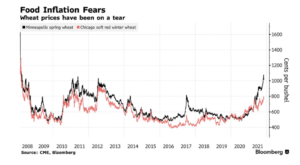China has secured at least 7 million tons of US soybeans after heavy buying in the past two weeks, passing the halfway mark toward meeting its 12-million ton purchase agreement…
Signs of Easing Chinese Demand, a Variable in Soy, Corn Availability
Reuters News reported this week that, “China’s soybean imports in October fell 41.2% from a year earlier, hitting the lowest level since March 2020, customs data showed on Sunday, as poor crush margins curbed demand and Hurricane Ida limited U.S. shipments.
“The world’s top buyer of soybeans brought in 5.11 million tonnes of the oilseed in October, versus 8.69 million tonnes a year earlier, General Administration of Customs data showed on Sunday.
Export inspections for U.S. #soybeans have not been at record levels lately, though they are certainly respectable for the time of year. Average for the last 4 weeks is 2.57 million tonnes/week (94.3 mln bu). pic.twitter.com/YGjxM2thLb
— Karen Braun (@kannbwx) November 8, 2021
“China’s soybean purchases in October were also down from the 6.88 million tonnes imported in September, the data showed.”
Top 10 U.S. export markets for #soybeans, by volume, https://t.co/uBFQbGNvgl @USDA_ERS
— Farm Policy (@FarmPolicy) November 6, 2021
* #China pic.twitter.com/qz228TETJE
The Reuters article indicated that,
China brought in 79.08 million tonnes of soybeans in the first 10 months of the year, down 5% from a year earlier.
“Hog farmers faced heavy losses throughout the summer months, though prices have picked up in October,” the Reuters article added.
In related news, Reuters writers Mark Weinraub and Marcelo Teixeira reported on Monday that, “Big U.S. harvests, near-perfect weather for planting in Brazil and signs of slowing purchases by top buyer China are bolstering supplies of two of the top globally traded commodities: soy and corn.
The rising stocks indicate that prices for those key crops, as well as for other staples such as sugar and coffee, may have peaked after the surge sparked by the onset of the pandemic, farmers, brokers and analysts said.
“Lower crop prices would be good news for consumers after global food prices soared to the highest level in a decade, according to the United Nations food agency.”
The Reuters article noted that, “Since topping out at near-decade highs in May, Chicago Board of Trade soybean futures have fallen 27% while corn futures fell 24% as near-perfect growing conditions across broad swaths of the United States led to a bountiful harvest.”
Top 10 U.S. export markets for #corn, by volume https://t.co/uBFQbGNvgl @USDA_ERS
— Farm Policy (@FarmPolicy) November 6, 2021
* #China pic.twitter.com/4F26vK9SmR
Weinraub and Teixeira added that, “But with the northwestern United States and Canada still reeling from a historic drought and dry weather potentially continuing there due to the La Niña climate phenomenon, prices of oats, wheat and canola are poised to remain high, meaning food inflation is far from over. Wheat futures recently surged to a nine-year top.
“The market for soybeans is under the most pressure, as rising supplies and concerns about a cooling of Chinese demand are pushing prices lower.”
And Bloomberg writer Sybilla Gross reported this week that, “For the second season in a row, the stars are favorably aligned for Australian wheat growers — a bumper harvest, a shortage of one of the world’s most important foods and global prices near nine-year highs.
Top 10 U.S. export markets for #wheat, by volume, https://t.co/uBFQbGNvgl @USDA_ERS
— Farm Policy (@FarmPolicy) November 6, 2021
* #Mexico, #China pic.twitter.com/kKwDCgNLoF
“Australia is set to ship 24.5 million tons in the coming season, says Rabobank, or near to the highest quantity ever. And another southern hemisphere country, Argentina, is on track to move out 13.5 million tons, also near to an all-time high, according to U.S. Department of Agriculture data. Together, these two nations are likely to account for almost 20% of world exports this season.”

The Bloomberg article indicated that, “The cargoes are sorely needed in a world bereft of the grain used in everything from bread and cakes, to biscuits and bagels. Droughts, frost and heavy rain in key northern hemisphere exporters this year have curbed supplies and sparked a buying frenzy in the Middle East. The surge in prices has helped push global food costs to the highest in a decade, adding to inflationary pressures.”





